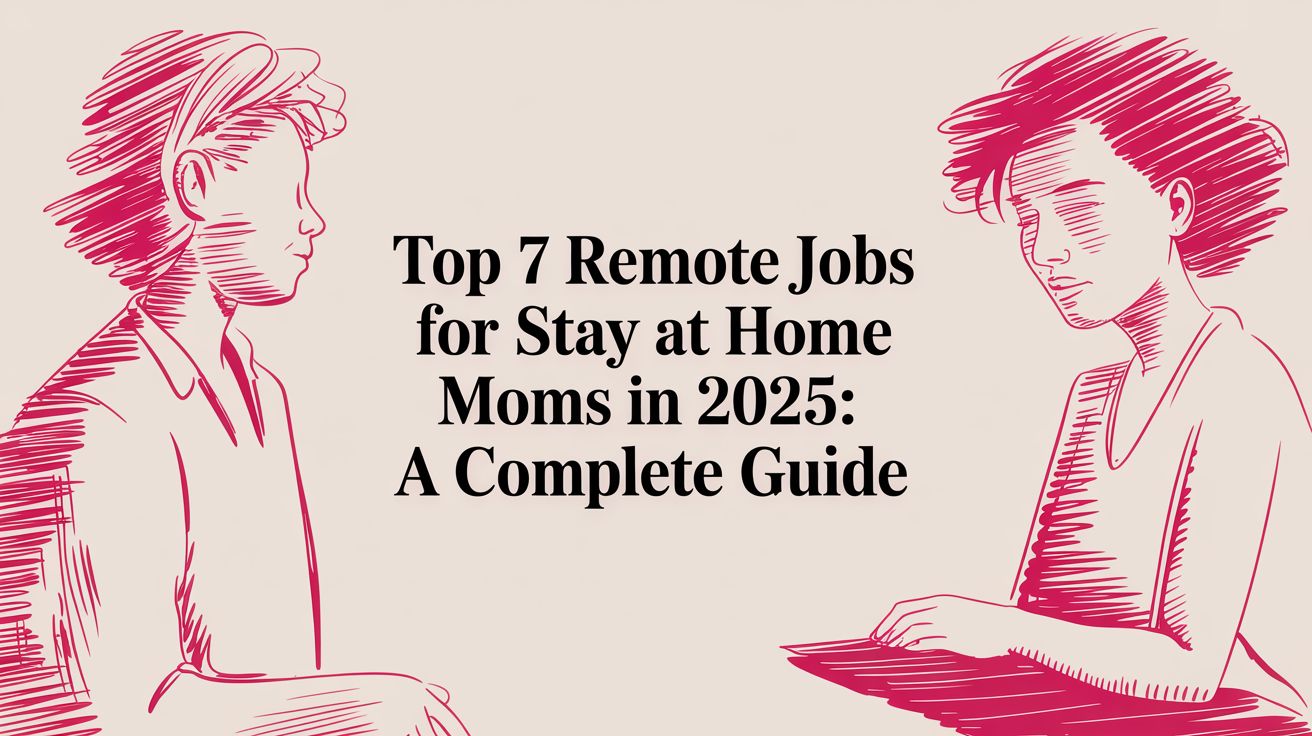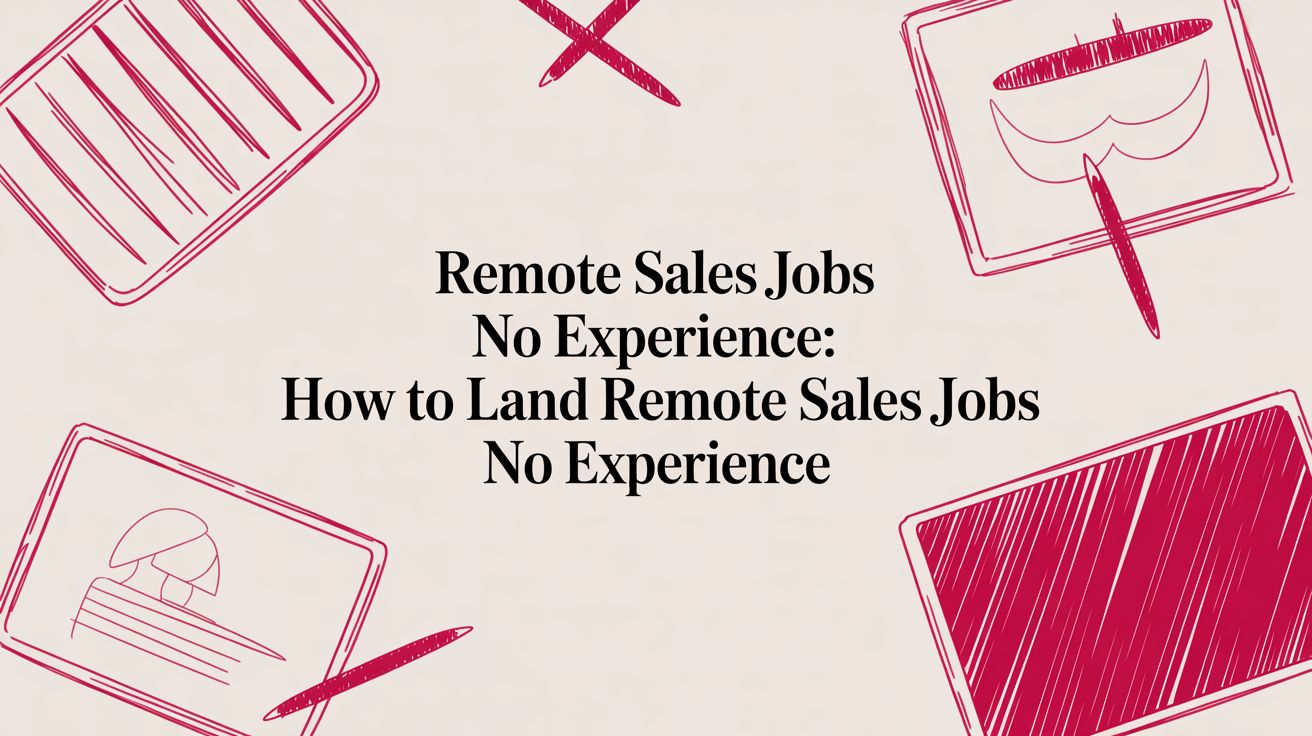How to Find a Remote Job You Actually Love
Max
To land a great remote job, you need more than a “spray and pray” approach to job boards. It’s about building a strategy. You have to sharpen your digital presence, zero in on industries where remote work is the norm (like tech and professional services), and truly grasp how competitive the market has become. Success means positioning yourself from day one as the perfect fit for a distributed team.
Navigating the Modern Remote Job Landscape

The hunt for a remote career has completely transformed. What used to be a niche perk is now a mainstream goal for millions, and that’s cranked up the competition to a whole new level. To stand out, you have to get real about the market you’re walking into. It’s not just about wanting flexibility—it’s about proving you can deliver results in an environment built on autonomy and digital communication.
The appeal of working from anywhere is undeniable, and the numbers back it up. While remote or hybrid roles account for only about 20% of all job postings, they pull in a staggering 60% of all applications. This massive gap means that for every single remote opening, hiring managers are buried under a mountain of resumes. To understand what’s driving this huge demand, you can check out our guide on the https://remotefirstjobs.com/blog/8-unbeatable-benefits-of-working-remotely-in-2025.
Understanding the Competitive Landscape
This kind of competition changes everything. Firing off a generic resume is a surefire way to get ignored. You need a targeted, thoughtful approach. The first step? Figure out which sectors are actually hiring remote workers.
To give you a better idea of where the opportunities are, here’s a look at the industries leading the remote work charge.
Top Industries for Remote Job Opportunities
A breakdown of the leading sectors offering remote positions, helping you target your search effectively.
| Industry | Share of Remote Postings | Example Roles |
|---|---|---|
| Professional Services | 24.3% | Management Consultant, Accountant, Legal Advisor |
| Technology | 18.3% | Software Developer, Cybersecurity Analyst, IT Support |
| Manufacturing | 11.4% | Supply Chain Manager, Logistics Coordinator, Quality Assurance |
These numbers tell a clear story. If you’re a project manager, for example, your time is much better spent targeting professional services firms than industries where remote work is still an exception. Knowing where to look is half the battle.
Adapting to New Work Dynamics
It’s not just about the numbers; the very nature of remote work has matured. Companies aren’t just experimenting anymore—they have firm expectations for their distributed teams. They’re looking for people who are not only masters of their craft but also pros at asynchronous communication, self-management, and proactive problem-solving.
As you navigate this new world, it’s also smart to stay aware of emerging legal shifts. For instance, things like Australia’s new right to disconnect laws are starting to redefine work-life boundaries for remote employees.
The key takeaway is this: finding a remote job today requires you to think like a marketer. You are the product, and your application is the campaign. It must be tailored, strategic, and compelling enough to capture attention in a saturated market.
Your immediate goal is to build a solid foundation by understanding these dynamics. This knowledge will shape every move you make, from how you write your resume to which companies you decide to pursue.
Building Your Remote-Ready Digital Footprint

When you’re chasing a remote job, your digital presence is more than just a formality. Think of it as your first handshake, your elevator pitch, and your interview all rolled into one.
A recruiter can’t gauge your vibe from a firm handshake or your office demeanor. Instead, they’re digging into your digital footprint. This means your LinkedIn profile, resume, and any portfolios need to work together, telling a compelling story about a candidate who is built for remote success.
A generic, one-size-fits-all resume just won’t cut it. To really stand out, you have to get inside the head of a remote hiring manager. They aren’t just scanning job titles; they’re hunting for specific keywords that signal you can thrive without someone looking over your shoulder. This is where strategic optimization becomes your secret weapon.
Weaving the Remote Narrative into Your Resume
Your resume needs to scream “remote-ready” from the first glance. This is about more than just listing past responsibilities—it’s about reframing your accomplishments to spotlight the skills that are non-negotiable for distributed teams.
Start by auditing your experience descriptions. Instead of saying you “managed a team,” try something like, “Led a cross-functional team across three time zones using Asana and Slack.” See the difference? The second version proves you have real, tangible experience with the tools and dynamics of remote collaboration.
Think about highlighting these key areas:
- Asynchronous Communication: Talk about projects where you relied heavily on written documentation, detailed updates, and clear handoffs—all without needing constant real-time meetings.
- Self-Management: Showcase instances where you took the initiative, owned your deadlines, and delivered results with minimal oversight. Phrases like “independently managed” or “autonomously executed” are gold.
- Proactive Problem-Solving: Describe a time you sniffed out a potential issue and solved it before it blew up. This shows foresight and a sense of ownership, which are critical when you’re not in the same room as your manager.
As you start reaching out to companies, remember that mastering professional email communication is non-negotiable. Your ability to write clearly and professionally is a direct reflection of how you’ll communicate as a remote team member.
Optimizing Your LinkedIn for Remote Recruiters
Let’s be real: your LinkedIn profile is often the very first place a recruiter looks after seeing your application. It absolutely has to back up the remote-ready story you’ve crafted in your resume. Your headline and “About” section are prime real estate for this.
Ditch the generic “Marketing Manager” headline. Go for something more specific and impactful, like: “Content Marketing Manager | Experienced in Leading Distributed Teams & Asynchronous Workflows.” This immediately tells any recruiter looking to find a remote job candidate that you have the right stuff.
Your “About” section is your chance to connect the dots. Don’t just list your skills. Weave them into your professional story. Explain how your project management experience directly prepared you for the discipline and autonomy needed to crush it in a work-from-home setting.
For an even deeper dive into positioning yourself effectively, our guide on https://remotefirstjobs.com/blog/how-to-find-remote-jobs offers a ton more strategies.
By meticulously curating your digital footprint, you stop being just another applicant in the pile. You become the obvious choice—a candidate who is ready to hit the ground running from day one, no matter where their desk is.
Finding High-Quality Remote Opportunities
Let’s be honest: the “spray and pray” method of job hunting is a soul-crushing waste of time. Firing off hundreds of applications into the black hole of massive, generic job boards is a direct path to burnout. A successful remote job search isn’t about volume; it’s about precision, strategy, and knowing exactly where the best opportunities are hiding.
You’ll rarely find top-tier remote roles on those sprawling aggregators that lump everything together—in-office, hybrid, and remote. Instead, you need to focus your energy on platforms built from the ground up for remote work. These are the places where companies with a genuine remote-first culture hang out. They aren’t just tolerating remote work; it’s baked into their DNA.
Beyond the General Job Boards
Think of your job search like fishing. You could cast a huge, clumsy net into the open ocean and hope you catch something worthwhile. Or, you could go straight to the well-stocked lake where you know the exact fish you want are swimming. Niche job boards are that lake.
Platforms that are exclusively for remote work are your best bet. A few of my go-tos include:
- We Work Remotely: One of the originals in the space. It’s known for high-quality, legitimate listings in tech, marketing, and customer support.
- Dynamite Jobs: This is an excellent spot for finding roles with established, often bootstrapped, remote companies that truly value autonomy and trust.
- RemoteOk: A major player with a huge, filterable list of global remote positions. It’s particularly strong for developers and designers.
When you use these specialized platforms, you’re automatically connecting with companies that already have the infrastructure, tools, and mindset to make a distributed team successful. This single shift in strategy dramatically increases your odds of finding a role where you can actually do your best work.
The goal is to spend your time applying for roles where you are a genuine contender, not just another number. Focusing on remote-first job boards automatically filters out companies that are merely remote-tolerant.
Decoding the Job Description
Once you find an opening that looks promising, it’s time to put on your detective hat and dissect the job description. It’s more than a list of duties; it’s a roadmap that reveals exactly what the company values in a remote hire. Look past the standard bullet points for clues about their remote culture.
Do they mention specific collaboration tools like Asana, Slack, or Notion? That’s a great sign they have a structured approach to asynchronous work. Do they specifically ask for experience working across different time zones? That tells you they’re a truly global and flexible team, not one that expects everyone to be online from 9-to-5 PST.
This level of analysis is a critical part of the process. For more ideas on where to concentrate your efforts, check out our insights on the best way to find remote jobs.
The demand for this kind of work isn’t slowing down. In fact, 51% of professionals now say they prefer fully remote roles. An overwhelming 90% of workers view remote work positively, pointing to better work-life balance as a primary reason. Explore more data on remote work trends from We Work Remotely. This massive shift is why the best companies are building their teams on remote-first principles, creating higher-quality opportunities for job seekers who know where to look.
Networking Authentically in a Remote World

Let’s be honest: networking can feel like a huge hurdle when you can’t grab coffee or meet up at industry events. But building a powerful professional network from your home office is more than possible—it just requires a different approach. The digital world is full of opportunities if you focus on genuine connection over just collecting contacts.
The secret is to flip your mindset from “what can I get?” to “what can I give?” This isn’t about firing off a hundred bland LinkedIn requests. It’s about playing the long game, building real relationships based on mutual respect and shared value. Start by contributing to conversations where your future colleagues and mentors are already hanging out.
Engaging in Digital Communities
Your people are out there, gathering online. You just need to know where to look. Think beyond your LinkedIn feed and start exploring the niche communities where you can actually provide value.
- Industry-Specific Slack Channels: So many professions have private or public Slack communities. Jump in, ask smart questions, and share your own expertise. It’s a much more casual and effective way to build rapport than a formal email.
- LinkedIn Groups: Find the active groups in your field. Don’t just be a lurker. Share an interesting article, leave a thoughtful comment on someone’s post, and join the discussion. Before you know it, you’ll become a recognizable voice.
- Virtual Events and Webinars: Don’t just watch—participate. Drop an insightful question in the Q&A, chat with other attendees, and follow up with the speakers afterward on LinkedIn. Mentioning something specific you enjoyed from their talk is a great way to make a memorable connection.
This strategy makes your eventual outreach feel warm and familiar, not cold and random. If you really want to succeed when you find a remote job, learning to build these connections is non-negotiable. For a deeper dive, check out this guide on effective networking strategies.
Mastering the Informational Interview
Once you’ve made a connection, asking for an informational interview is a fantastic next step. This isn’t a backdoor way to ask for a job—it’s a genuine request for their advice and perspective. Keep your message short, be respectful of their time, and be crystal clear about why you’re reaching out to them specifically.
Pro Tip: Your first message is everything. Ditch the generic templates. Instead, mention a specific article they wrote, a project they led, or a comment they made that stuck with you. This little bit of personalization proves you’ve done your homework and actually value their unique insights.
By shifting your focus to authentic engagement and giving value first, networking stops being a chore. It becomes a way to build a real support system. These are the people who will think of you when the perfect remote role opens up, giving you a massive advantage in a competitive market.
Winning the Remote Interview
So, you’ve landed the interview. This is it—the final performance where you prove you’ve got the goods. But for a remote role, it’s about more than just your skills. You need to show you have the discipline, communication chops, and self-starting attitude to crush it from day one, no matter where you are.
Your first impression is made the second your video feed connects, long before you say a word. Your setup says a lot about your professionalism. Get your camera at eye level—no one wants to look up your nose. Make sure your lighting is bright and in front of you, not behind, so you don’t look like a silhouette. And please, check your audio. A crisp, clear sound without echoes or background noise is non-negotiable.
That cluttered background? It can subtly scream “disorganized.” A simple, clean wall, a tidy bookshelf, or even a tasteful virtual background works wonders. Do a full tech check at least an hour before the call. Trust me, you don’t want to be scrambling with a software update two minutes before you’re supposed to log on.
Articulating Your Remote Readiness
Okay, your tech is dialed in. Now for the real test: proving through your answers that you’re built for remote work. Hiring managers are listening for clues that you’re a proactive communicator who can manage their own time and solve problems independently.
This is where you need to show, not just tell. The best way to do this is with the STAR method (Situation, Task, Action, Result). It’s a simple framework for turning a generic answer into a compelling story.
- Situation: Set the scene. What was the project or challenge?
- Task: What was your specific role or responsibility?
- Action: What exact steps did you take to get it done?
- Result: What was the outcome? Use numbers whenever you can.
Let’s say they ask how you handle projects with minimal supervision. Instead of saying, “I’m a great self-starter,” try this:
“In my last role (Situation), my team was tasked with launching a new marketing campaign across two time zones (Task). I took the lead on project management, setting up a detailed plan in Asana, creating an asynchronous update schedule, and running weekly check-ins to keep everyone aligned (Action). The result? We launched the campaign 10% ahead of schedule and drove a 25% increase in qualified leads (Result).”
See the difference? That’s not a claim; it’s proof. For more tips on what to expect, check out our deep dive on acing the process with these essential remote interview tips.
Proving Your Value as a Remote Employee
Companies aren’t just hiring remote talent to be trendy. They’re doing it because it works. The data backs this up—one study found a 35% to 40% increase in productivity among remote employees, with over 60% of workers feeling more productive at home. When you can prove you thrive in this setting, you’re not just a good hire; you’re a smart business decision. You can learn more about the state of remote work from Neat’s 2025 report.
The ultimate goal of a remote interview isn’t just to talk about your skills; it’s to demonstrate them in real-time. Clear communication, a professional setup, and well-structured answers all prove you have what it takes to succeed outside a traditional office.
Get your stories ready. Think about times you showed your tech-savviness, solved a problem on your own, or collaborated seamlessly using digital tools. Show them you’re the candidate they’ve been looking for to fill that crucial find a remote job opening.
Common Questions About Finding a Remote Job

Diving into the remote job search often brings up a ton of questions. It’s just a different beast than a traditional job hunt, with its own unique quirks and challenges. Let’s tackle some of the most common questions we hear from job seekers.
Getting clear, direct answers is the best way to move forward with confidence. We’ll clear up the biggest uncertainties so you can focus on what really matters—landing an amazing remote role.
How Can I Stand Out Without Prior Remote Experience?
This is easily the question we get asked most often. The good news? It’s far from a deal-breaker. The trick is to shift the conversation away from a specific “remote” job title and toward the transferable skills that prove you’re ready for an autonomous role. Your resume and interviews need to tell a story of self-discipline and rock-solid digital communication.
Think back to projects where you had to manage your own timeline or work with minimal supervision. Those are your golden tickets.
- Showcase Autonomy: Talk about projects where you took the reins from start to finish.
- Emphasize Digital Communication: Name-drop the tools you’ve used—like Slack, Asana, or Microsoft Teams—to collaborate with colleagues who weren’t sitting next to you.
- Highlight Proactive Updates: Frame your experience to show you’re the kind of person who communicates progress without needing constant check-ins.
When you frame your past experiences this way, you’re showing you already have the DNA of a successful remote employee, even if you’ve never officially held a “remote” title.
Are Remote Jobs More Competitive Than In-Office Roles?
The short answer: yes, they usually are. Because remote roles aren’t tied to a specific city, companies can attract talent from a much, much wider pool. A single job opening can easily get hundreds—sometimes thousands—of applications from qualified people all over the world.
The competition isn’t just a feeling; it’s a statistical reality. Remote and hybrid positions consistently attract a massively high volume of applications compared to the number of roles available.
This intense competition means your application strategy has to be on point. A generic, one-size-fits-all resume is a surefire way to get lost in the shuffle. You have to tailor every single application to the specific company and role, highlighting the exact skills they’re looking for. It’s the only way to find a remote job in a crowded market.
What Red Flags Should I Watch for in Job Postings?
While the vast majority of remote job postings are perfectly legitimate, scams are out there. Learning to spot the red flags is crucial for protecting your time, energy, and personal information. A little healthy skepticism goes a long way.
Here are a few warning signs that should make you pause:
- Vague Job Descriptions: If the posting is fuzzy on day-to-day duties, required skills, or what the company actually does, be careful.
- Unprofessional Communication: Keep an eye out for emails coming from personal domains (like @gmail.com or @yahoo.com) instead of a corporate address.
- Upfront Costs: No legitimate employer will ever ask you to pay for training, software, or equipment as a condition of getting hired. Ever.
- Pressure to Act Fast: Be wary of offers that seem too good to be true or push you to make an immediate decision without going through a real interview process.
For a deeper dive, our guide on how to find legitimate work-from-home jobs can help you search more safely. At the end of the day, trust your gut. If something feels off, it probably is.


